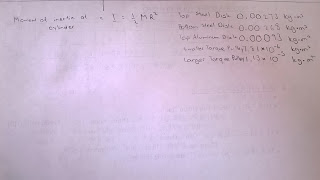Daniel Guzman
Rodrigo Uribe
May 15, 2017
Introduction
In this lab we were trying to determine what variable will affect angular acceleration, the hanging mass, the change of the spinning disk or the pulley.
Procedure:
We first made sure that all of our lab equipment was clean. From there, we made sure to take some measurements of the lab equipment as shown in the data table below. We measured the mass of each equipment using a scale and we measured the diameter using a caliper.
We first plug the power supply into the Pasco rotational sensor. If there is a cable withe the yellow paint or tape, connect only that cable to the Lab Pro at Dig/Sonic 1, so the computer is reading the top disk. If the cables are the same, connect them both. You will need to discern which is measuring the top disk and ignore the other sensor.
Set up the computer. Open the Logger Pro. There is no defined sensor for this rotational apparatus so we will need to create something that works with this equipment. Choose Rotary Motion. There are 200 marks on the top disk, so you will need to set the Equation in the Sensor Settings to 200 counts per rotation. When you collect data, you can see graphs of angular position, angular velocity and angular acceleration vs. time. the graph of angular acceleration vs. time is useless due to the poor timing resolution of the sensors. Do not use this graph.
Make sure the hose of the clamp on the bottom is open so that the bottom disk will rotate independently of the top disk when the drop pin is in place.
Turn on the compressed air so that the disks can rotate separately. You will not so much air that you op the hose from the air source, but enough to keep things smooth. Set the disks spinning freely to test the equipment.
With the string wrapped around the torque pulley and the hanging mass at its highest point, start the measurements and release the mass. Use the graphs of angular velocity to measure the angular acceleration as the mass moves down and up.
By increasing the hanging mass, we can see that the average angular mass increases. By increasing the rotating mass we can see that the angular acceleration decreases. We can see that by increasing the radius of the pulley, the angular acceleration increases.
Also in this lab we want to know the moment of inertia of the system. We can do this because we know we can calculate it by adding the various parts of each equipment inertia up.
Conclusion
In this lab I learned how various variable can affect angular acceleration in certain ways whether it be increasing or decreasing. I also learned how we can find a the moment of the system.



No comments:
Post a Comment